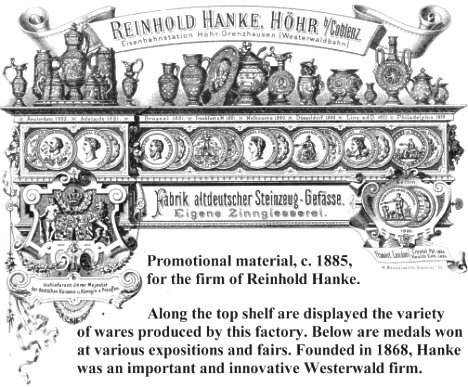by Master Steinologist Jack Lowenstein
(Prosit, March 1991)

|
Stein Collectors International, Inc. |
by Master Steinologist Jack Lowenstein (Prosit, March 1991) |
 |
| This thumbnail history was taken from a large descriptive poster in the Westerwald Ceramics Museum, Höhr-Grenzhausen, translated by the author. The popular name for this area is Kannenbäckerland, hence, "Land of Jug Bakers" or "Jug Bakers’ Land". Today the area generally includes the Westerwald cities of Höhr-Grenzhausen, Grenzau and Baumbach. | |
| 14th century | Hard-fired stoneware starting ca. 1350, red-brown and flamed utilitarian articles. |
| 1402 | First documented mention of potters in the town of Höhr. |
| End 16th century | Blue-grey salt-glazed stoneware. Master potters from Siegburg and Raeren relocate to the Westerwald area. |
| 1643 | Cooperative Guild, with its own Guild coat-of-arms, of all "jug-" and "stein-bakers" living within a 5-mile radius of Grenzhausen. |
| 17th century | The golden era of Westerwald stoneware. |
| After 1650 | Manganese violet is used as glaze colorant in addition to cobalt blue. |
| 1771 | More than 600 potters work in the Westerwald. |
| 1776 | The "pipe-bakers" Guild of the Electoral District of Trier ((Kurtrier). |
| 1786 | First documented mention of "Jug Bakers’ Land" (Kannenbäckerland) |
| 1804 | Termination of the Trier District jug-bakers’ Guild. |
| 1814 | Termination of the local jug-bakers’ Guild. |
| 1846 | Beginning of mechanized manufacture; the first clay-cutting machine in Höhr. |
| 1863 | First clay pipe (conduit) press in Höhr. |
| 1865 | First steam-driven machine in Höhr. |
| 1868 | Reinhold Hanke founds the first "Fine Stoneware Factory" (Feinsteinzeugfabrik) in jug-bakers’ land. First appearance of "Historismus". |
 |
|
| 1879 | First stein press in Baumbach. |
| 1882/83 | First round furnaces in Höhr and Grenzhausen. |
| 1894 | Approximately 270 ceramic establishments, with about 2000 employees, in jug bakers’ land. |
| After 1900 | Beginning of Jugendstil stoneware. Well-known artists prepare designs for Westerwald stoneware: Ernst Laurenty, Henry van de Velde, Richard Riemerschmid, Paul Wynand, Peter Behrens, among others. |
| 1902 | Development of copper red glazes in the salt furnace. |
| After 1920 | Introduction of slip-molding in jug bakers’ land. |
| Since 1927 | Resurgence of artistic handiwork (Elfriede Balzar-Kopp and Wim Mühlendyck). |
| 1952 | First gas-fired tunnel kiln in the Land of the Jug Bakers. |
| Mid-1983 | The last of the wood-fired salt-glazing furnaces is shut down because of environmental considerations; only furnaces equipped with gas-scrubbing equipment may be used for salt-glazing. |
|
All rights reserved. |